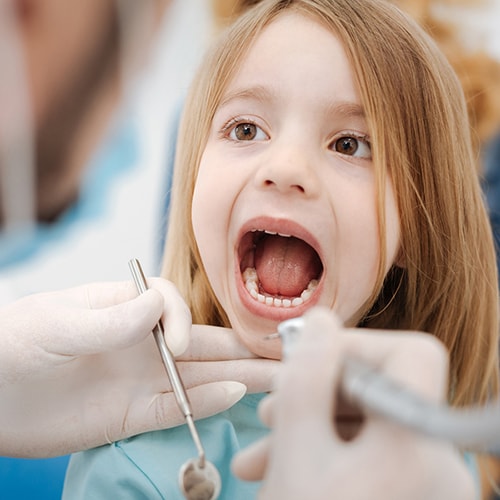You've provided dental care for your littlest patients through teething and learning to brush, and now it's time to help them grow into healthy school-aged children. This is an exciting time for your patients! From tooth injuries to braces, Pediatric dental care takes on an integral role in the health and well-being of children ages 6 to 11.
Oral Hygiene
Around age 6, children begin losing primary teeth and gaining permanent teeth. It is important to emphasize brushing twice daily with fluoride toothpaste, in the morning after breakfast and just before bed in the evening, and daily flossing for teeth contacting each other in the arch. Children still need assistance and supervision brushing until their fine motor skills are developed — around the age they can tie their own shoes, which is typically at 6 to 7 years-of-age. Flossing can be performed by parents/guardians until age 8.
Remind families of proper brushing technique using tools like in-office demonstrations and instructional videos. Children's toothbrushes should be replaced every three months or at the first sign of wear, whichever comes first. Young children are exposed to a host of germs and a toothbrush should be replaced after a cold, the flu, a mouth infection or a sore throat.
Pediatric Dental Care and Development
From ages 6 to 11, our young patients are growing, and their dentition is in transition. Parents and their children often don't know or notice that the first permanent molars - the '6-year-old molars' - typically erupt around age 6 and that they erupt in the mouth behind the primary dentition without any baby teeth being lost. Make sure to let parents and their children know about this, and encourage them to check the area and to brush extra carefully as these teeth start to erupt. On the other hand, on occasion a parent or child may notice a permanent tooth further forward erupting before the primary tooth is lost. Parents and children should be encouraged to visit your office if a baby tooth lingers after the permanent tooth appears. Most children have grown out of finger-sucking habits by now. If not, or if young patients are grinding their teeth, offer advice - and treatment if needed. Nail biting and pencil-biting are other things to let parents and patients know about, as these can cause damage to teeth and encourage bruxism.
Remind patients and parents that regular dental visits are important to monitor the teeth as they develop and change. This is also the age to begin monitoring for interceptive orthodontics. Some children may have missing, supernumerary or fused teeth that may be best treated while their bones are still growing. If patients lost primary teeth early, a space maintainer may be needed to help avoid tooth movement and future crowding. Interceptive orthodontics may also be needed for specific skeletal issues, malocclusion or crossbites. At age 11, patients have entered the late mixed dentition stage which ends around age 13 - crowding, functional and aesthetic concerns now become the main focus in orthodontic referrals.
Caries Prevention
School-aged children at risk for dental caries, for instance because of sticky or sugary snacks or drinks, can benefit from periodic application of fluoride varnish. In some cases, a high-fluoride toothpaste may be needed. When the first permanent molars erupt, if the child is at risk for caries, sealants should be placed to protect the occlusal surface. Patients should preferably know about this protective treatment before the child reaches the stage when these teeth is erupting.
Children in orthodontic treatment have a greater caries risk than the general pediatric population, so they and their parents/guardians should be taught how to brush and floss around their appliances - or if its a removable appliance, to remove it, perform oral hygiene and to then re-insert the appliance. Encourage orthodontic patients to use a toothbrush to clean in and around braces (fixed appliances), and to use a rinse for an extra level of protection to help prevent white spots.
Traumatic Injuries
Elementary school children are always on the go, which means their teeth are prone to injury. Advise your patients and their parents of the importance of a clean, well-fitting mouth guard for contact sports to reduce the risk of dental and orofacial trauma. In addition, you can give parents advice and information on what to do after an injury, including if a tooth is avulsed.
The school-aged years are an adventurous time. Our patients are growing and changing quickly, and our job of maintaining their healthy smiles becomes an ever-more dynamic and rewarding process.
About the Author
Mirissa D. Price is a 2019 DMD Candidate at Harvard School of Dental Medicine and future pediatric dentist. She serves as a Scholar of Dental Education at Harvard School of Dental Medicine and a Give Kids A Smile Leadership Ambassador. Mirissa's research and outreach interests include social-emotional development in youth; addressing barriers and access to pediatric dental care; interprofessional collaboration; and dental education. Mirissa uses her medical experiences to inspire others, living each day with a passion to spread pain-free smiles through her dental work, writing, improv comedy performances, and nonprofit work with children. You can stay up to date with Mirissa's writing at mirissaprice.wordpress.com and follow @Mirissa_D_Price on Twitter or Facebook.

